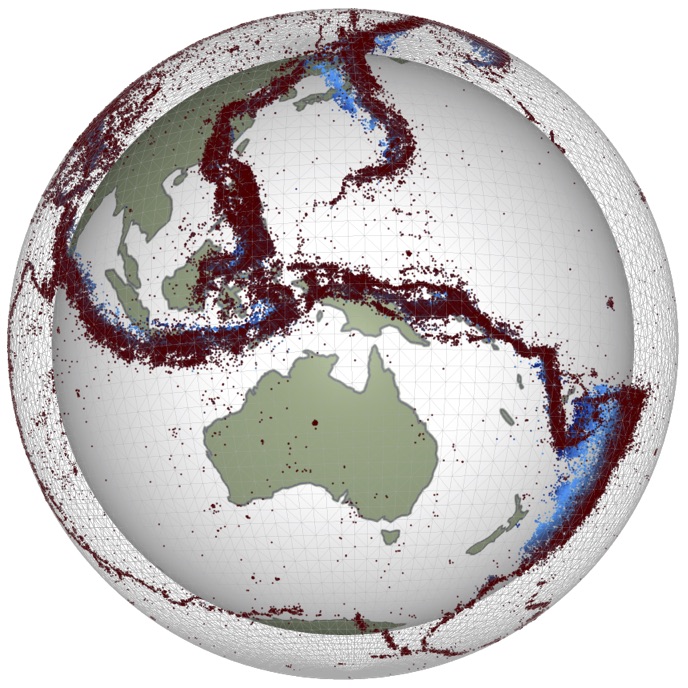Cylindrical Stokes with Coriolis term (out of plane)#
We implement Stokes/Navier-Stokes flow in a disc with rigid bc’s and take into account the effect of Coriolis terms \(2\Omega \times \mathbf{u}\).
The non-linear implementation in Stokes flow relies on the Newton (SNES) solver but the structure of the solution (with strong Coriolis terms) is very different from the Stokes flow pattern (especially the pressure gradients) and so we instead set up a Navier-Stokes problem in which we can down-weight the inertial effects but retain a time-evolution terms to approach the solution. In this example, I am using the same trick as for the SS benchmark case where I try to suppress the time dependent term in the Navier-Stokes equation and replace timesteps with pseudo timesteps.
This works best if we spin-up the rotation gradually.
# to fix trame issue
import nest_asyncio
nest_asyncio.apply()
import petsc4py
from petsc4py import PETSc
import underworld3 as uw
import numpy as np
import sympy
expt_name = "SS_NS_flow_coriolis_10"
import meshio
# meshball = uw.meshes.SphericalShell(
# dim=2, radius_outer=1.0, radius_inner=0.0, cell_size=0.05, degree=1, verbose=True
# )
meshball = uw.meshing.Annulus(radiusOuter=1.0, radiusInner=0.0, cellSize=0.05, degree=1, centre=False, verbosity=True)
v_soln = uw.discretisation.MeshVariable("U", meshball, 2, degree=2)
p_soln = uw.discretisation.MeshVariable("P", meshball, 1, degree=1)
t_soln = uw.discretisation.MeshVariable("T", meshball, 1, degree=3)
v_soln_1 = uw.discretisation.MeshVariable("U_1", meshball, meshball.dim, degree=2)
vorticity = uw.discretisation.MeshVariable("omega", meshball, 1, degree=1)
swarm = uw.swarm.Swarm(mesh=meshball)
v_star = uw.swarm.SwarmVariable("Vs", swarm, meshball.dim, proxy_degree=3)
remeshed = uw.swarm.SwarmVariable("Vw", swarm, 1, proxy_degree=3, dtype="int")
X_0 = uw.swarm.SwarmVariable("X0", swarm, meshball.dim, _proxy=False)
swarm.populate(fill_param=4)
# Create a density structure / buoyancy force
# gravity will vary linearly from zero at the centre
# of the sphere to (say) 1 at the surface
import sympy
radius_fn = sympy.sqrt(
meshball.rvec.dot(meshball.rvec)
) # normalise by outer radius if not 1.0
unit_rvec = meshball.rvec / (1.0e-10 + radius_fn)
gravity_fn = radius_fn
# Some useful coordinate stuff
x = meshball.N.x
y = meshball.N.y
r = sympy.sqrt(x**2 + y**2)
th = sympy.atan2(y + 1.0e-5, x + 1.0e-5)
#
Rayleigh = 1.0e2
# Surface-drive flow, use this bc
# vtheta = r * sympy.sin(th)
# vx = -vtheta*sympy.sin(th)
# vy = vtheta*sympy.cos(th)
# Create NS object
navier_stokes = uw.systems.NavierStokesSwarm(
meshball,
velocityField=v_soln,
pressureField=p_soln,
velocityStar_fn=v_star.fn,
u_degree=v_soln.degree,
p_degree=p_soln.degree,
rho=1.0,
theta=0.5,
verbose=False,
projection=True,
solver_name="navier_stokes",
)
navier_stokes.petsc_options.delValue(
"ksp_monitor"
) # We can flip the default behaviour at some point
navier_stokes._u_star_projector.petsc_options.delValue("ksp_monitor")
navier_stokes._u_star_projector.petsc_options["snes_rtol"] = 1.0e-2
navier_stokes._u_star_projector.petsc_options["snes_type"] = "newtontr"
navier_stokes._u_star_projector.smoothing = 0.0 # navier_stokes.viscosity * 1.0e-6
navier_stokes._u_star_projector.penalty = 0.0001
# Here we replace the time dependence with the steady state advective transport term
# to lean towards steady state solutions
navier_stokes.UF0 = (
-navier_stokes.rho * (v_soln.fn - v_soln_1.fn) / navier_stokes.delta_t
)
# Constant visc
navier_stokes.rho = 1000.0
navier_stokes.theta = 0.5
navier_stokes.penalty = 0.0
navier_stokes.viscosity = 1.0
navier_stokes.bodyforce = 1.0e-32 * meshball.N.i
navier_stokes._Ppre_fn = 1.0 / (
navier_stokes.viscosity + navier_stokes.rho / navier_stokes.delta_t
)
# Velocity boundary conditions
navier_stokes.add_dirichlet_bc((0.0, 0.0), "Upper", (0, 1))
navier_stokes.add_dirichlet_bc((0.0, 0.0), "Centre", (0, 1))
v_theta = (
navier_stokes.theta * navier_stokes.u.fn
+ (1.0 - navier_stokes.theta) * navier_stokes.u_star_fn
)
t_init = sympy.cos(3 * th)
# Write density into a variable for saving
with meshball.access(t_soln):
t_soln.data[:, 0] = uw.function.evaluate(t_init, t_soln.coords)
print(t_soln.data.min(), t_soln.data.max())
navier_stokes.bodyforce = Rayleigh * unit_rvec * t_init # minus * minus
navier_stokes.solve(timestep=10.0)
with meshball.access():
v_inertial = v_soln.data.copy()
with swarm.access(v_star, remeshed, X_0):
v_star.data[...] = uw.function.evaluate(v_soln.fn, swarm.data)
X_0.data[...] = swarm.data[...]
swarm.advection(v_soln.fn, delta_t=navier_stokes.estimate_dt(), corrector=False)
# check the mesh if in a notebook / serial
def plot_V_mesh(filename):
if uw.mpi.size == 1:
import pyvista as pv
import underworld3.visualisation as vis
pvmesh = vis.mesh_to_pv_mesh(meshball)
pvmesh.point_data["T"] = vis.scalar_fn_to_pv_points(pvmesh, t_soln.sym)
velocity_points = vis.meshVariable_to_pv_cloud(navier_stokes.u)
velocity_points.point_data["V"] = vis.vector_fn_to_pv_points(velocity_points, navier_stokes.u.sym)
pl = pv.Plotter(window_size=(1000, 750))
pl.camera.SetPosition(0.0001, 0.0001, 4.0)
# pl.add_mesh(pvmesh,'Black', 'wireframe')
pl.add_mesh(
pvmesh,
cmap="coolwarm",
edge_color="Black",
show_edges=True,
use_transparency=False,
opacity=0.5,
)
pl.add_arrows(velocity_points.points, velocity_points.point_data["V"], mag=0.05)
pl.screenshot(
filename="{}.png".format(filename),
window_size=(2560, 2560),
return_img=False,
)
pl.close()
del pl
ts = 0
swarm_loop = 5
for step in range(0, 50):
Omega = 10.0 * meshball.N.k * min(ts / 25, 1.0)
navier_stokes.bodyforce = Rayleigh * unit_rvec * t_init # minus * minus
navier_stokes.bodyforce -= (
2.0 * navier_stokes.rho * sympy.vector.cross(Omega, v_theta)
)
delta_t = 10.0 * navier_stokes.estimate_dt()
navier_stokes.solve(timestep=delta_t, zero_init_guess=False)
dv_fn = v_soln.fn - v_soln_1.fn
_, _, _, _, _, _, deltaV = meshball.stats(dv_fn.dot(dv_fn))
with meshball.access(v_soln_1):
v_soln_1.data[...] = 0.5 * v_soln_1.data[...] + 0.5 * v_soln.data[...]
with swarm.access(v_star):
v_star.data[...] = uw.function.evaluate(v_soln.fn, swarm.data)
swarm.advection(v_soln.fn, delta_t=delta_t, corrector=False)
# Restore a subset of points to start
offset_idx = step % swarm_loop
with swarm.access(swarm.particle_coordinates, remeshed):
remeshed.data[...] = 0
remeshed.data[offset_idx::swarm_loop, :] = 1
swarm.data[offset_idx::swarm_loop, :] = X_0.data[offset_idx::swarm_loop, :]
# re-calculate v history for remeshed particles
# Note, they may have moved procs after the access manager closed
# so we re-index
with swarm.access(v_star, remeshed):
idx = np.where(remeshed.data == 1)[0]
v_star.data[idx] = uw.function.evaluate(v_soln.fn, swarm.data[idx])
if uw.mpi.rank == 0:
print(
"Iteration (pseudo timestep) {}, dt {}, deltaV {}".format(
ts, delta_t, deltaV
)
)
if ts % 1 == 0:
# nodal_vorticity_from_v.solve()
plot_V_mesh(filename="output/{}_step_{}".format(expt_name, ts))
# savefile = "output/{}_ts_{}.h5".format(expt_name,step)
# meshball.save(savefile)
# v_soln.save(savefile)
# p_soln.save(savefile)
# vorticity.save(savefile)
# meshball.generate_xdmf(savefile)
navier_stokes._u_star_projector.smoothing = navier_stokes.viscosity * 1.0e-6
ts += 1
# check the mesh if in a notebook / serial
if uw.mpi.size == 1:
import pyvista as pv
import underworld3.visualisation as vis
pvmesh = vis.mesh_to_pv_mesh(meshball)
pvmesh.point_data["T"] = vis.scalar_fn_to_pv_points(pvmesh, t_soln.sym)
pvmesh.point_data["P"] = vis.scalar_fn_to_pv_points(pvmesh, p_soln.sym)
velocity_points = vis.meshVariable_to_pv_cloud(navier_stokes.u)
velocity_points.point_data["V"] = vis.vector_fn_to_pv_points(velocity_points, navier_stokes.u.sym)
pl = pv.Plotter(window_size=(1000, 750))
# pl.add_mesh(pvmesh,'Black', 'wireframe')
pl.add_mesh(
pvmesh,
cmap="coolwarm",
edge_color="Black",
show_edges=True,
scalars="P",
use_transparency=False,
opacity=0.5,
)
pl.add_arrows(velocity_points.points, velocity_points.point_data["V"], mag=0.033)
pl.show(cpos="xy")
((v_inertial - usol) ** 2).mean()
v_inertial.max()

